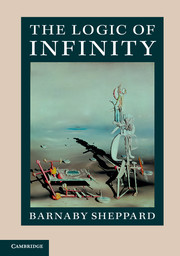Book contents
- Frontmatter
- Contents
- Preface
- Synopsis
- 1 Introduction
- 2 Logical foundations
- 3 Avoiding Russell's paradox
- 4 Further axioms
- 5 Relations and order
- 6 Ordinal numbers and the Axiom of Infinity
- 7 Infinite arithmetic
- 8 Cardinal numbers
- 9 The Axiom of Choice and the Continuum Hypothesis
- 10 Models
- 11 From Gödel to Cohen
- A Peano Arithmetic
- B Zermelo–Fraenkel set theory
- C Gödel's Incompleteness Theorems
- Bibliography
- Index
11 - From Gödel to Cohen
Published online by Cambridge University Press: 05 August 2014
- Frontmatter
- Contents
- Preface
- Synopsis
- 1 Introduction
- 2 Logical foundations
- 3 Avoiding Russell's paradox
- 4 Further axioms
- 5 Relations and order
- 6 Ordinal numbers and the Axiom of Infinity
- 7 Infinite arithmetic
- 8 Cardinal numbers
- 9 The Axiom of Choice and the Continuum Hypothesis
- 10 Models
- 11 From Gödel to Cohen
- A Peano Arithmetic
- B Zermelo–Fraenkel set theory
- C Gödel's Incompleteness Theorems
- Bibliography
- Index
Summary
The constructible universe
It can be shown that a mathematical web of some kind can be woven about any universe containing several objects. The fact that our universe lends itself to mathematical treatment is not a fact of any great philosophical significance.
–Bertrand Russell (attributed)Constructing a simple universe
Gödel proved the relative consistency of the Axiom of Choice and the Generalized Continuum Hypothesis with Gödel-Bernays set theory by explicitly constructing a model in which both statements hold.
In the introduction to his 1940 Princeton lecture notes The Consistency of the Continuum Hypothesis Gödel describes the theory he is using:
The system Σ of axioms of set theory which we adopt includes the axiom of substitution [Fraenkel's axiom of substitution] and the axiom of ‘Fundierung’ [the axiom of foundation]… It is essentially due to P. Bernays… and is equivalent with v. Neumann's system [with a minor modification]… The system Σ has in addition to the ∈-relation two primitive notions, namely ‘class’ and ‘set’.
The axioms of Σ are listed in the first chapter and are compared with those of Bernays. The translation of Gödel's results from his version of set theory to ZF is not too difficult. I will distort history in this chapter in connection with Gödel's results, as I have done throughout, harmlessly pretending that he worked in ZF.
- Type
- Chapter
- Information
- The Logic of Infinity , pp. 383 - 410Publisher: Cambridge University PressPrint publication year: 2014



